Next: About this document ... Up: Chapter 2: Circuit Principles Previous: Two-Port Networks
All circuits we have discussed so far are only composed of passive components (resistors, capacitors and inductors) driven by current and/or voltage sources. Later we will consider circuits containing active components such as bipolar junction transistors (BJT), field-effect transistors (FET), operational amplifiers (op-amps) containing many transistors, and voltage amplifiers. These active components can be considered as controlled voltage or current sources as functions (typically linear) of the input voltage or current.
 : It is desirable to have
a large
: It is desirable to have
a large  so that little input current is drawn from the source,
i.e., the source is minimally affected by the amplifier as a load.
Ideally
so that little input current is drawn from the source,
i.e., the source is minimally affected by the amplifier as a load.
Ideally
 .
.
 : It is desirable to
have a small
: It is desirable to
have a small  so that little voltage drop across this resistance
will result when the load of the amplifier draws a current from the
amplifier, i.e., the load will minimally affect the output voltage of
the amplifier.
so that little voltage drop across this resistance
will result when the load of the amplifier draws a current from the
amplifier, i.e., the load will minimally affect the output voltage of
the amplifier.
 (or
(or  in op-amp):
The open-circuit voltage
in op-amp):
The open-circuit voltage  across the output port is related
to the input voltage
across the output port is related
to the input voltage  by
by
 .
.
 (or
(or  in BJT transistor):
The short-circuit current
in BJT transistor):
The short-circuit current  through the output port is related
to the input current
through the output port is related
to the input current  by
by
 .
.
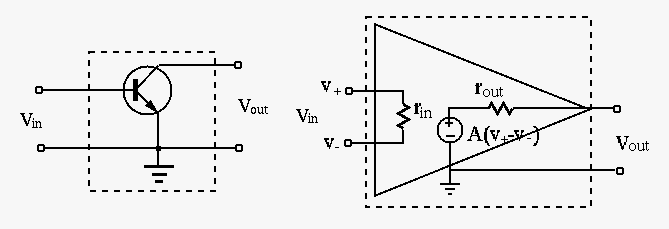

Example 1: Consider the circuit below containing an active component,
a voltage amplifier, model by the three parameters 





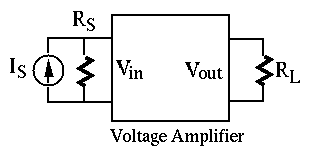
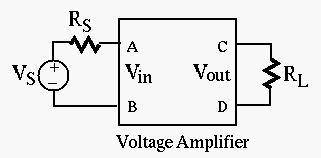
 |
(133) |
 |
(134) |
 and
and  , we want to maximize
, we want to maximize  by
maximizing
by
maximizing  and minimizing
and minimizing  .
.

 : This is the resistance between
the two terminals A and B of the input port, while a load
: This is the resistance between
the two terminals A and B of the input port, while a load  is
connected to the output port between terminals C and D:
is
connected to the output port between terminals C and D:
 |
(135) |
 is affected by the load
is affected by the load  .
.
 : According to Thevenin's theorem,
any one-port network can be treated as an ideal voltage source
: According to Thevenin's theorem,
any one-port network can be treated as an ideal voltage source  in
series with a resistance
in
series with a resistance  . We apply this theorem to the output port
and define the output resistance as the Thevenin resistance
. We apply this theorem to the output port
and define the output resistance as the Thevenin resistance
 |
(136) |
 with an internal resistance
with an internal resistance  is applied
to the input port. In general,
is applied
to the input port. In general,  is affected by
is affected by  of the source.
of the source.
 : This is the ratio of the
open-circuit output voltage
: This is the ratio of the
open-circuit output voltage  (
(
 ) to an ideal voltage
source
) to an ideal voltage
source 
 |
(137) |
Example 2:
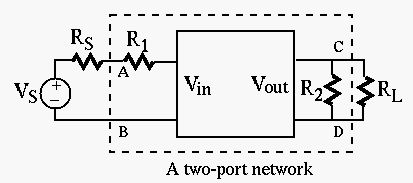
Find 







 .
.
 , and get the open-circuit voltage
, and get the open-circuit voltage
 and the short-circuit current
and the short-circuit current
 . The output resistance is
. The output resistance is
 |
(138) |
 can be found as the resistance between the two
terminals C and D of the output port when the voltage source of the amplifier
is turned off (short-circuit), i.e.,
can be found as the resistance between the two
terminals C and D of the output port when the voltage source of the amplifier
is turned off (short-circuit), i.e.,
 .
.
 across the output port to the voltage
across the output port to the voltage  across the input port, when the
output port is an open circuit, i.e.,
across the input port, when the
output port is an open circuit, i.e.,
 .
.
 |
 |
 |
|
 |
 |
 |
|
 |
 |
 |
(139) |
 ,
,  and
and  can be used in more complicated circuits.
can be used in more complicated circuits.
Example 3:
A 2-port network with a voltage aplifier modeled by 





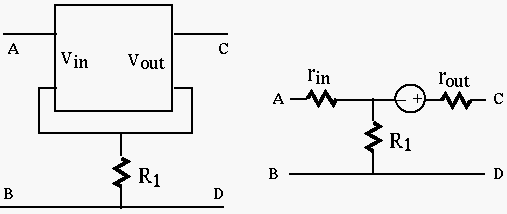
 .
Applying an ideal voltage source
.
Applying an ideal voltage source  to the input, we get the voltage
to the input, we get the voltage
 across
across  and
and  across
across  , respectively:
, respectively:
 |
(140) |
 |
(141) |
 |
(142) |
 , the circuit is reduced to the original voltage amplifier and we
have
, the circuit is reduced to the original voltage amplifier and we
have  .
.
We first find the short-circuit current 


 |
(143) |
 |
(144) |
 and
and  , we get
, we get
 |
(145) |
 is
is
 |
(146) |
 |
(147) |
 is affected by internal resistance
is affected by internal resistance  of the source.
When
of the source.
When  ,
,
 |
(148) |
 ,
,
 .
.
 to the input port, while the output port is connected to a
load
to the input port, while the output port is connected to a
load  . The input resistance is
. The input resistance is
 where
where  is
the input current. Applying the KVL to the two loops of this circuit, we
get
is
the input current. Applying the KVL to the two loops of this circuit, we
get
 |
(149) |
 |
(150) |
 and
and  ,
we get
,
we get
 |
(151) |
 |
(152) |
 is affected by the load
is affected by the load  . When
. When
 ,
,
 , i.e., the input resistance is much increased.
Moreover, if
, i.e., the input resistance is much increased.
Moreover, if  , the circuit is reduced to the original voltage
amplifier with
, the circuit is reduced to the original voltage
amplifier with
 .
.
 shared by both the input and output loops
serves as a negative feedback:
shared by both the input and output loops
serves as a negative feedback:
 |
(153) |
 is reduced but both the input and
output resistances are improved, i.e.,
is reduced but both the input and
output resistances are improved, i.e.,  is increased and the
is increased and the  is reduced.
is reduced.
Example 4: (Homework)
The transistor emitter follower and the op-amp buffer shown below are very important circuits which find wide applications in practice. These two circuits can be similarly modeled based on the individual models of the transistor and the an op-amp (the inner dashed boxes), also shown in the figure. Note that the two models are equivalent (the outter dashed boxes), as the non-ideal current and voltage in the models can be converted to each other.

The parameter 


We can now find the three parameters of the model of the two circuits:
 , where
, where  is the source
voltage applied across A and B,
is the source
voltage applied across A and B,  is the current through the
input port, when a load
is the current through the
input port, when a load  is connected to the output port between
C and D.
is connected to the output port between
C and D.
 , where
, where  and
and
 are the open-circuit voltage and short-circuit current when
an ideal source voltage
are the open-circuit voltage and short-circuit current when
an ideal source voltage  (with
(with  ) is applied to the input
port.
) is applied to the input
port.
 .
.
Example 5: (Homework)

Two amplifiers with parameters 








Find the power gain 
Example 6: (Homework)
The input and output resistances 








Assume 








